Archive for January, 2009
Yesterday I spent most of the day spinning a small skein of baby camel - It’s a hard life. This will be knitted into a sample for the upcoming Spin Short class at Socktopus.

The fibre is about 1 inch long, and dreamily soft and fuzzy. The spun yarn is uber-squooshable and I think will have to be something soft and cowl-y to cosy around my neck. I thought about dyeing it, but the natural camel colour is quite nice so I think I’ll leave it. I guess my next day of work will involve knitting it up - poor me!
 5 Comments » 5 Comments »
 Posted by: Diane in General
Posted by: Diane in General
The budget is tight this year, so with the possibility of not being able to buy any new yarn all year staring me in the face (eeek!) I have decided to clear some of the things I just know I’m never going to get around to using :-)
Rather than cut and paste everything into this post, I have listed it all on Ravelry - visit my ‘For Sale‘ page to see what’s up for grabs.
I also have:
Vogue Ultimate Knitting Book, perfect condition, £18. Sold
230g Alpaca/Nylon combed top, this is natural white and will make fabulous sock yarn, £10.
Prices do not include postage, this will be charged at 2nd class RM rates which you can check here, unless you want it sooner!
 4 Comments » 4 Comments »
I love my Rose, I love her big bobbins, which fit almost twice as much as an Ashford bobbin. I love that I can spin laceweight at a ratio of 31:1 if I want to. But I have discovered a flaw…
When you can only fit 50g or so on a bobbin, the natural course of action is to spin two bobbins of 25g and then ply them together, rinse, repeat. When your bobbins fit 100g it’s easy to think: ‘Right then, I’ll just do it in two halves then - easy!’ Have you any idea how long it takes to spin 50g of lace onto a bobbin? And not be allowed to do anything else in between? (I knew I’d never go back to it if I started something else!).
I’ll tell you - about a week for each. Luckily, this fibre is absolute heaven to spin, so I didn’t get grumpy, just occasionally a little bored. But then I looked at the yarn and went all smiley again.
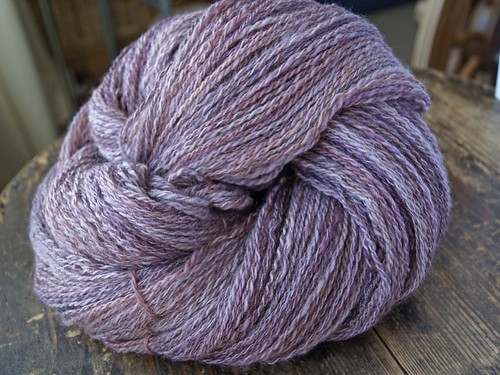
Specs
Fibre: Oceanwind Knits Merino in ‘Elderberry’ from Socktopus.
Ratio: 21.9
Draft: Long draw from the fold
Wpi: sorry, never checked
Yards: about 500yds/4oz, more if you stretch it more. Well, it’s an inexact science. But there were 324 blinking strands of yarn on my niddy noddy.
Destiny: Most probably a Flower Basket shawl
And I’d do it again like a shot :-D Although maybe half at a time…
 11 Comments » 11 Comments »
 Posted by: Diane in Spin-In
Posted by: Diane in Spin-In
A common question that new spinners ask me is “What else do I need to be able to spin?” If you are spinnng, you already have a spindle or wheel, and some fibre, and this is really all you need - the bare essentials, and you can spin happily for years without getting anything else. But there is also a load of other equipment out there that could make your spinning experience more varied, more enjoyable, or a faster process. Today I’ll give you a run-down of some spinning tools and accessories, and explain briefly what they are used for.
Carders or Hand-cards
This is often one of the first extra pieces of equipment that a new spinner buys. Carders are oblong pieces of wood with a handle, and are covered on one side with carding cloth, which has little steel teeth that trap the fibres. They are used as a pair and can be flat-backed or curved. Carded fibres are rolled up into rolags and are used to spin woolen yarns, or can be rolled so the fibres are parallel to spin a semi-worsted yarn.

Carders are almost essential if you are working with unprocessed fleece (it is possible to spin a good fleece without them if you tease the locks out with your fingers), and are very handy for blending fibres together. They come in a couple of different sizes - it’s best to get the larger ones as the size of the carders limits the length of the fibre you can use them with. Carders are also available in range of grades - finer fibres call for finer, more closely-set teeth.
Flick-carder
A flick-carder is used on its own and is much smaller than a carder, and covered with a similar carding cloth. It is used to open out fibres in a lock of wool, this can then be carded more easily, or spun directly from the opened-out lock. There is a great article on flick-carders in the Summer 2008 issue of Spin-Off. A dog comb, not to be confused with wool combs (below), is another handy tool which can be used to the same purpose as a flick carder.
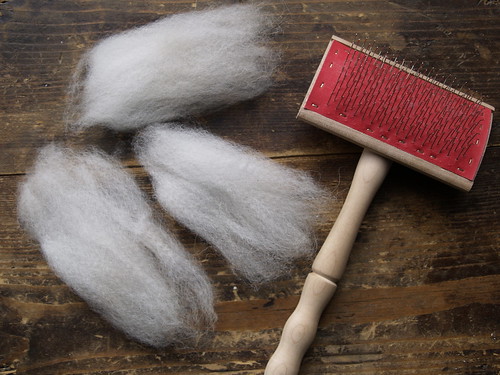
Drum Carder
A drum carder is essentially a much larger version of a pair of hand cards, having two or more cylindrical barrels covered in carding cloth. It does the same job, but much more quickly, and produces large batts of airy, carded fibre. Visit Vampy’s blog for some fantastic tutorials on drum carding.
Wool Combs
These murderous-looking tools are used to produce combed top for true worsted spinning. They consist of a wooden base and handle, with one or more rows of long, sharp tines at a right angle. They are used in pairs, often with one clamped to a table. (The combs in this picture are of the smallest size, with only one row of tines.)
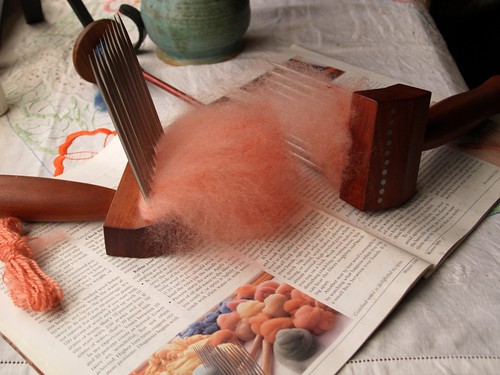
They are lovely for long fibres, and the resulting prep is fabulous to spin, although takes a bit more work than carding or flicking. Wool combs are often used in conjunction with a diz, a small concave tool with a hole in it through which the fibres are drawn off to create a continous length of combed top.
Hackle
A hackle is built with tines like those on wool combs, but is much wider. It is used for blending fibres, which can be drawn off with a diz into combed top. You can see a hackle being used to blend colours and fibres in this video. Hackling is also an essential part of the process in preparing flax for spinning. The flax fibres are drawn through the hackle many times to soften and separate them, and to strip away any woody bark.
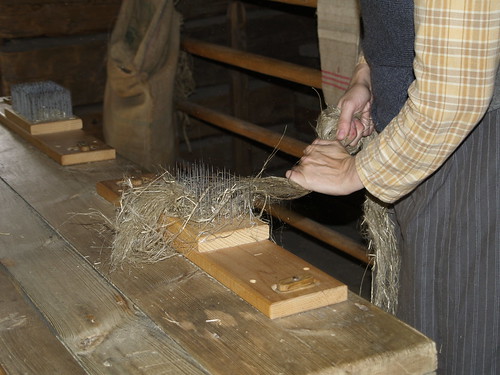
Niddy Noddy
All handspun yarn will benefit from being wound into a skein and finished with steam or a nice bath. You can wind skeins around chairlegs, your arms or a large box, but it is quite a lot easier with a niddy noddy. Two arms sit perpendicular to each other and are joined by a shaft in the middle. The yarn is wound up and down over the arms in a long loop. A mini niddy noddy is handy for sample skeins.

Lazy Kate
Many wheels come with a Lazy Kate, somtimes built in as part of the wheel. The construction varies, all you need is rods to hold your bobbins or spindle cops, fixed to some sort of base. You can quickly improvise a Lazy Kate from a shoe-box and knitting needles, or there is a huge choice available to buy.
Tensioned Lazy Kates are very popular - they are fitted with a band (similar to a scotch tension band) which goes around the bobbins and attaches to an adjustable knob. Tensioning the bobbins stops them from free-spinning when you pull the singles off as you ply. This can lead to tangles in the singles or uneven plying.
Distaff
Distaff attachments are available for several models of spinning wheels, and can also be free-standing. The distaff is a post to which the fibre mass is attached, making it easy to draw off fibres as you spin. It is necessary when using extremely long fibres such as flax, and is also handy if you have a large, unmanageable mass of any fibre. Spindle spinners sometimes use small distaffs either hanging from the wrist or stuck into the belt, keeping the fibre tidy should they need to walk around while spinning.
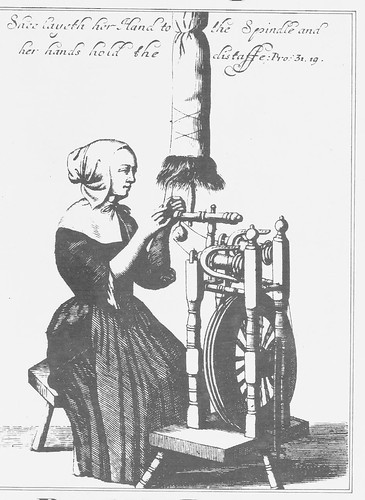
- - - -
Anything I’ve forgotten? I’ll add more if I think of things, or feel free to request!
Please come by Lingr tonight for a chat - I’m not sure when I’ll be around, but definitely by 8.30 and most probably earlier.
 22 Comments » 22 Comments »
Last Saturday a friend of mine came over for a lesson, and, since she’s absolutely brilliant, and was feeling sorry for me in my sick-ridden state, she brought me a present. She was heading off to NYC for a couple of weeks for work, and she left with me her new drumcarder - yay!
So I grabbed the pile of this:

that I had sitting around waiting for just such an opportunity (Oatmeal BFL and Alpaca/Silk, both from P&M). And had an awful lot of fun making these:
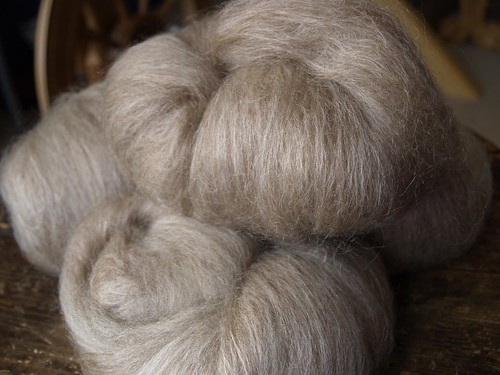
They’re only 30g each and I have about 10 more to do! But it’s loads of fun. Then I started digging through boxes and found these:

which seemed to match in a rather meant-for-each-other kind of way. On the left is some NDS Halo, and dyed tussah silk on the right. I made this:
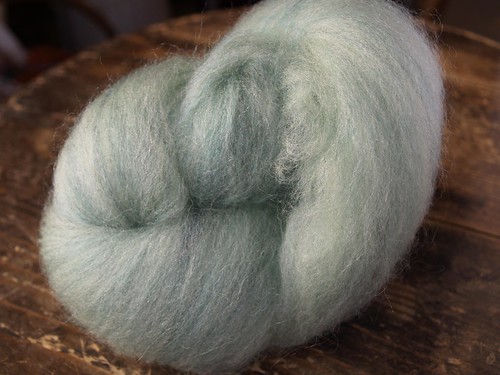
I can see why people get very excited about their drum-carders! There has been more being fed through it, but that’s all I have photos of for now. Sadly, my suspicion that I have no space to have one permanently has been borne out. The borrowed one is living in a highly inconvenient corner of the living room atm and I can’t see it becoming a long-term fixture.
- - - - -
While not carding luscious batts, I have been busy at the wheel. I was all set to launch into the main spinning for the Deep-V Argyle, but I decided, when I was ill, that I needed to spoil myself so I dug out a bump of Oceanwind knits from the Christmas pile and thought I’d just ‘quickly spin up’ some luxury merino. Famous last words.
I spent the last two weeks working exclusively on this project, and only the sheer delight of this fibre has kept me from ditching it in the middle. Here’s some:

I just spent two hours plying it. I haven’t skeined it off and measured the yardage yet, but I’d guess it’s somewhere in the region of 500m. It will be a shawl, and I am pretty sure it will be as much like heaven to knit as it was to spin.
- - - - -
Tomorrow is the Road Trip to P&M Woolcraft - double yay! There’s a bunch of us going, there will be cookies, and fibre to squidge, and new bobbins so I can spin five different things at a time! Have a great weekend, I’ll see you on Sunday.
 6 Comments » 6 Comments »
 Posted by: Diane in IYNF, Spin-In
Posted by: Diane in IYNF, Spin-In
Being a bit of a natural fibre junkie, I was thrilled to learn that 2009 would be a year dedicated to promoting them. This series of articles will cover twelve natural fibres over the year, I hope you enjoy them! Read more about the International Year of Natural Fibres at http://www.naturalfibres2009.org/.
Part One: Wool
Wool is the general term for the hair grown by sheep. For millennia, it has been a prized natural fibre, although nowadays it accounts for only around 5% of the world’s fibre consumption. Fragments of wool fabric up to 6000 years old have been found in Egypt and Europe, and historical records emphasise the value of wool as a trading commodity across Europe, Northern Africa and the Middle East. No doubt these ancient spinners and weavers enjoyed wool for much the same reasons that we do now. A soft, light, readily-renewable fibre, it is warm when wet, fire resistant and takes dye colour beautifully. It has huge variety in type allowing for a multitude of uses and is pleasant to work with. What’s not to like!
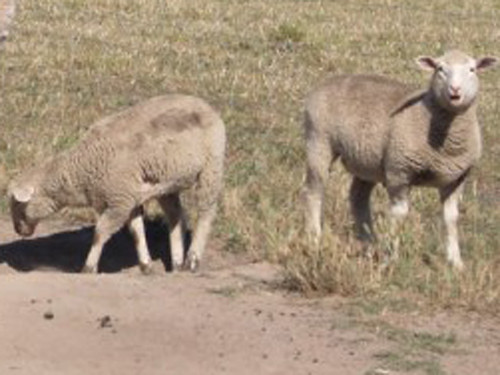
Harvesting
Although some primitive breeds still shed their fleece in clumps, in general the wool is clipped off with shears on a regular basis, usually once per year. The protective lanolin in the fleece is washed out and the fibres are carded or combed to prepare them for spinning. The first fleece a lamb produces (called a hogg, or hoggit fleece) is often particularly fine in quality, but subsequent fleeces do not vary remarkably; the grade of fleece from a particular animal will continue to be of similar quality until old age. Thus, if you happen across an extra good fleece, and you know the animal it came from, it is worth keeping the information ready for next year’s shearing time.
Structure
Wool is a protein fibre and comprises an outer sheath and inner cortex. Covering the sheath, or cuticle is a thin layer of overlapping scales. These scales enable the fibre to matt and felt, creating dense, warm cloth, and they are in most cases what people with wool sensitivities are reacting to. Superwash wools have been treated to either smooth or remove these scales; treated wool can feel less ‘prickly’ and is much harder to felt.
Fibre Characteristics
The main characteristics that set wool apart from other hair fibres are its crimp and elasticity. Wool fibres are very strong, even when wet, and can stretch up to another two thirds in length and still return to the original state. This and the natural crimp in the fibres help to create yarn which is soft, lofty and springy. These characteristics, along with the slightly textured surface of the fibres due to the scale structure, make wool an easy fibre to spin as it readily clings to itself to form yarn.
Varieties
Different breeds of sheep can live in widely varying climates and are farmed all over the world. As a hand-spinner or knitter, you will probably have come across many different types of wool. A huge variety of breeds of sheep produce an enormous choice of wools, from the finest Merino right up to the coarse rug wools. A fine Merino may have a micron* measurement of 18, and Bradford Count of 80; a Wensleydale fleece may have a micron of 32, or a BC of around 50. In general, fine wools are shorter and more suited to next-to-skin garments, but are less durable, coarse wools will generally be longer in staple, and will have the durability needed for upholstery fabrics or outer garments. (Below: Polwarth – a fine wool, and English Leicester – longwool).
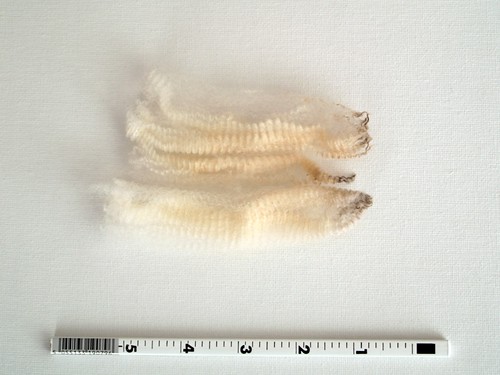

Wool is by far my favourite of all natural fibres. I love its character, the ease of spinning and the way it feels in a knitted or woven garment. It may also have something to do with the little bit of sheep I have in my blood, but whatever the reason, it will almost always be my first choice when I’m looking for something to spin.

Do you have questions? What are your experiences with wool – like it? Love it? Leave a comment or come by the Lingr chatroom on Sunday evenings.
Sources/further reading
Fournier and Fournier, “In Sheep’s Clothing�? Interweave Press, 1995.
Wayland Barber, E., “Women’s Work�? Norton, 1994.
Wikipedia - Wool
* The fineness of fibre is measured in two ways: with a micron measurement – determining the exact diameter of the individual fibre, or with the Bradford Count – a measurement based on the amount of yarn that can be spun from an ounce of fibre.
 6 Comments » 6 Comments »
 Posted by: Diane in 52in52
Posted by: Diane in 52in52
 The Well of Lost Plots by Jasper Fforde The Well of Lost Plots by Jasper Fforde
Book series sometimes get a bit lame towards the middle or the end (film series too), just ask anyone who’s still persevering with Wheel of Time. Thursday Next #3, however, is still up there with the best and I can’t wait to get my hands on number four.
View all my reviews.
 2 Comments » 2 Comments »
I learned a few things this past week:
- I get sick of chicken soup really quickly, no matter how good it is. However, the local deli (source of the good soup) also makes a completely rockin’ lasagne (mmmm…) which actually requires less effort to heat up and clean up after than the soup.
- It is far less boring to sleep 20 hours per day than to be wide awake but feeble.
- If you work for yourself, compared to teaching in a school, when you are sick no-one does your work for you while you’re away.
- Dishes and laundry don’t do themselves either :-(
Ok, maybe some of these I could have figured out anyway with a little common-sense. But small things seem big when you’re ill ya know.
On the upside, the feeble-o-metre dropped low enough yesterday to allow me to finish the Peacock Tail and Leaf Scarf which I cast on on Christmas Eve. The gorgeous handspun yarn was my Christmas gift from Kai, and it was a sheer delight to knit, not just in itself but also due to the love and care that went into it. Thank you so much sweetie!
and if you needed further proof of the glory and magic of blocking:
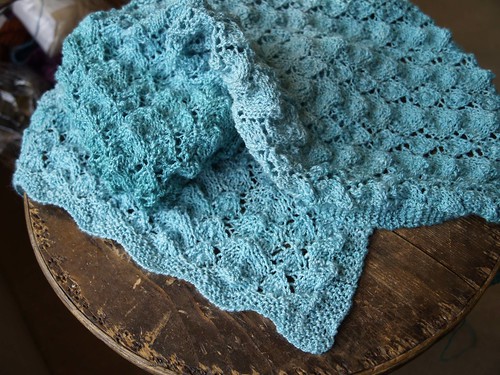

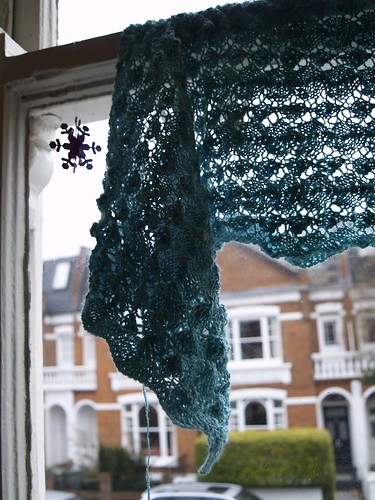

I left off the edging at each end, I like it, but I wanted to squeeze all the scarf I could out of this yarn and it was easier to just have a garter edge and knit till I ran out (I had 14 inches of yarn left - ugh!)
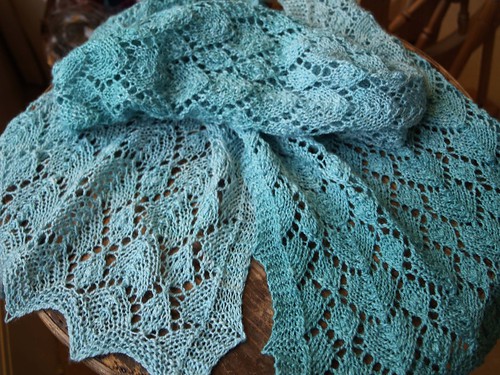
This is a great project, by one of my favourite designers. It was interesting enough that it never once felt repetative, simple enough to knit while semi-conscious and looks stunning.
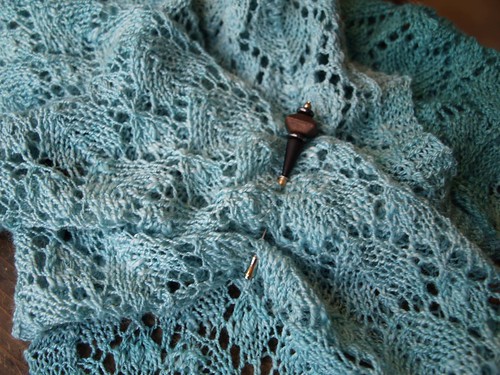
And it’s all for me! The shawl pin, btw, was also a gift from Kai. It goes well, n’est-ce pas?
 12 Comments » 12 Comments »
 Posted by: Diane in General
Posted by: Diane in General
Today I crawled out from under the duvet and surveyed the world (partially hidden under drifts of Kleenex) once more. I have managed to shower (yay!), almost get dressed, and start a load of laundry (although who knows whether it will get hung up to dry).
My remaining goals for the day involve staying awake for more than three hours at a stretch and perhaps a few rows of knitting.
Normal programming will resume shortly. I hope.
 10 Comments » 10 Comments »
A little while ago, an Australian pal of mine opened up an Etsy shop and started breaking down our fibre resolutions by offering the lushest of hand-dyed Polwarth…
Here’s some he sent me, in a variation of the ‘Dingo’ colourway, all spun up now into a big pile of squoodgy lovliness.

I can thoroughly recommend this prep, and the dyeing and the fantastic service. David has other fibres as well, but really what could you want besides Polwarth? There’s an update tonight - even if you don’t want to buy anything please go check out Come In Spinner and wave hello from me :-D
 8 Comments » 8 Comments »
|



























 Entries (RSS)
Entries (RSS)